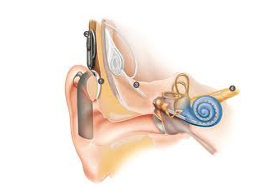Cochlear Implants are often a next solution for our patients, when their hearing aids are not providing enough assistance. Many people start by wearing two hearing aids. However, as hearing loss progresses, you may need something more. To improve your hearing performance and help you understand more clearly, you may need to consider a solution that helps you hear your best with both ears. For many, a cochlear implant in one ear and a hearing aid in the other can provide a richer more natural hearing experience. This combination is referred to as bimodal hearing.
At ChEARS Hearing Center, we conduct candidacy evaluations to determine if an implant might be right for you. We also support recipients of cochlear implants by meeting their needs for initial activation, interim programming, troubleshooting, upgrades, and even equipment orientation.
What is a Cochlear Implant?
A cochlear implant (also known as a “CI”) is a way to stimulate the auditory nerve via electrical stimulation. Instead of having a hearing aid deliver sound via an acoustic pathway, the cochlear implant bypasses the damaged hair cells in the cochlea (the organ of hearing), and makes direct contact with the auditory nerve to deliver sound via electrical impulses. Patients with cochlear implants still have to wear an external device similar to a hearing aid that will pick up sound and deliver it to the internal implant via a magnet that is placed underneath the scalp.

